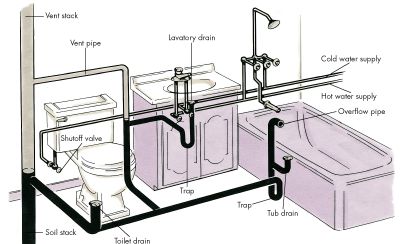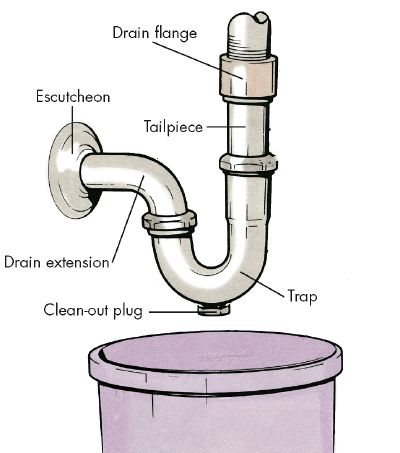
...................................................................................................................................................
BY FIX-IT CLUB
Plumbing follows the basic laws of nature
-- gravity, pressure, water seeking its own level.
Knowing this, you can understand its
"mysteries" and make dozens of fixes to your home's plumbing system.
You can save yourself time, trouble, and money!
The plumbing system in your home is composed of
two separate subsystems. One subsystem brings freshwater in, and the other
takes wastewater out.
The water that comes into your home is under
pressure. It enters your home under enough pressure to allow it to travel
upstairs, around corners, or wherever else it's needed.
As water comes into your home, it passes through
a meter that registers the amount you use. The main water shutoff, or stop,
valve is typically located close to the meter.
In a plumbing emergency, it's vital that you
quickly close the main shutoff valve. Otherwise, when a pipe bursts, it can
flood your house in no time.
If the emergency is confined to a sink, tub, or
toilet, however, you may not want to turn off your entire water supply.
Therefore, most fixtures should have individual stop valves.
Water from the main supply is immediately ready
for your cold water needs. The hot water supply, however, requires another step.
One pipe carries water from the cold water
system to your water heater. From the heater, a hot water line
carries the heated water to all the fixtures, out-lets, and appliances that
require hot water.
A thermostat on the heater maintains the temperature
you select by turning the device's heating elements on and off as required.
The normal temperature setting for a home water
heater is between 140 degrees F and 160 degrees F, but 120 degrees F is usually
adequate and is also more economical.
Some automatic dishwashers require
higher temperature water, though many of these have a water heater within them
that boosts the temperature another 20 degrees F.
Drainage Systems
Whether your home is on a sewer or septic system, the systems within your
home are essentially the same.
Drainage systems do not depend on pressure, as
supply systems do. Instead, waste matter leaves your house because the drainage
pipes all pitch, or angle, downward.
Gravity pulls the waste along. The sewer line
continues this downward flow to a sewage treatment facility or a septic tank.
While the system sounds simple, there's more to
it, including vents, traps, and clean outs.
The vents sticking up from the roof of your
house allow air to enter the drainpipes. If there were no air supply coming
from the vents, wastewater would not flow out properly and the water in the
traps would need to be siphoned away.
Traps are vital components of the drainage
system. You can see a trap under every sink. It is the curved or S-shape
section of pipe under a drain.
Water flows from the basin with enough force to
go through the trap and out through the drainpipe, but enough water stays in
the trap afterward to form a seal that prevents sewer gas from backing up into
your home.
Every fixture must have a trap. Toilets are
self-trapped and don't require an additional trap at the drain.
Bathtubs frequently have drum traps, not only to
form a seal against sewer gas but also to collect hair and dirt in order to
prevent clogged drains.
Some kitchen sinks have grease traps to collect
grease that might otherwise cause clogging.
Because grease and hair are generally the causes
of drain clogs, traps often have clean-out plugs that give you easier access to
remove or break up any blockage.
Since a drainage system involves all of these
components, it is usually referred to as the DWV: the drain-waste-vent system.
If water is to flow out freely and waste is to
exit properly, all components of the DWV must be present and in good working
order.
Examine the pipes in the basement or crawl space under your house to help you
understand the system better.
Supply and Drainage Subsystems
The supply and drainage subsystems are two
distinct operations, with no overlapping between them.
There are bridges between the two, however, and
the bridges are what make the plumbing system worth having. In plumbing jargon,
any bridge between the supply and drainage systems is a fixture.
Toilets, sinks, and tubs are fixtures. In
addition, an outside faucet is a fixture and so is a washing machine.
All devices that draw freshwater and discharge
wastewater are fixtures, and all are designed to keep the supply and drainage
systems strictly segregated.
Some fixtures have individual supply shutoff
valves so you don't need to close the main shutoff to repair them.
It's a good idea to make sure everyone in the
family knows the location of the main shutoff valve in your house as well as
how to use it. You may want to tag the main shutoff valve so anyone can easily
find it.
Before you embark on any plumbing repairs,
always turn off the water supply to the fixture or the main shutoff.
In addition, check with your local plumbing code
official before you add or change any pipe in your house.
You will learn what is allowed and what is
prohibited and whether or not a homeowner is allowed to do his or her own work.
If you get the green light, you can save
yourself a lot of money by doing your own repairs.
Fix-It
Club® is founded and operated by Dan Ramsey and Judy
Ramsey, authors of numerous popular how-to books for homeowners and consumers.
Click HERE for our
Fix-It Club site map, a list of our FREE Fix-It Guides. Visit HERE to read our
latest Fix-It Club Blog Posts. Please contact us for website advertising opportunities.

 |
Your home's supply and drainage system must
always be two distinct subsystems, with no overlapping. At the fixtures
(bridges between the two systems), the air admitted by the vent stack and vent
pipes keeps the traps sealed and prevents sewer gases from backing up through
the drains.
|
 |
Some sink traps have a clean-out plug that
enables you to clean the trap without having to remove it from the drain.
|
 |
Fixtures should have individual supply shutoff
valves so that you don't need to close the main shutoff to make repairs at the
fixture.
|

No comments:
Post a Comment